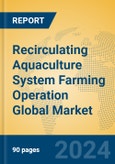Often termed “land-based aquaculture,” RAS excels in freshwater production, with 90% of EU RAS output in freshwater and 10% in sea and brackish water. Advanced RAS boasts recycle ratios of 95-99%, contrasting with traditional flow-through systems’ 0%. Projects targeting marine species like Atlantic salmon are rising across continents. The market thrives on sustainability demands, urbanization, and innovations in water treatment, positioning RAS as a future-proof solution for protein supply.
Market Size and Growth Forecast
The global RAS Farming Operation market is projected to reach USD 5 billion to USD 6 billion in 2025, with a CAGR of 10% to 12% through 2030, potentially expanding to USD 8 billion to USD 10 billion, driven by sustainability and seafood demand.Regional Analysis
- North America: Expected at 9% to 11%, the U.S. and Canada lead with premium RAS projects. Trends focus on salmon and urban markets.
- Europe: Forecasted at 10% to 12%, Norway and Denmark dominate with advanced systems. Trends emphasize sustainability and marine species.
- Asia Pacific: Projected at 11% to 13%, China and Japan drive growth with large-scale adoption. Trends favor freshwater efficiency.
- Middle East and Africa (MEA): Anticipated at 8% to 10%, the UAE explores RAS for food security. Trends lean toward brackish water.
- South America: Expected at 9% to 11%, Chile tests RAS potential. Trends focus on scalability.
Product Type Analysis
- Freshwater Farming: Projected at 9% to 11%, it dominates with established technology. Trends emphasize efficiency and scale.
- Sea and Brackish Water Farming: Expected at 11% to 13%, it targets marine species like salmon. Growth shifts to technological advancements.
Key Market Players
- Aquabounty: A biotech leader, Aquabounty pioneers RAS for genetically enhanced fish.
- Atlantic Sapphire: A frontrunner, Atlantic Sapphire focuses on land-based salmon.
- Aquaco: A solutions provider, Aquaco excels in RAS technology.
- Nordic Aquafarms: A Scandinavian firm, Nordic targets sustainable seafood.
- Whole Oceans: A U.S. player, Whole Oceans emphasizes premium RAS production.
- West Coast Salmon: A regional leader, West Coast focuses on salmon farming.
- Pure Salmon: An innovator, Pure Salmon advances global RAS operations.
- Blue Star Foods: A diversified firm, Blue Star explores RAS potential.
Porter’s Five Forces Analysis
- Threat of New Entrants: Moderate, with high capital and technical expertise barriers, though declining tech costs enable niche entrants.
- Threat of Substitutes: Moderate, with traditional aquaculture and wild fish competing. RAS stands out for sustainability.
- Bargaining Power of Buyers: High, as retailers demand consistent, eco-friendly supply, pressuring cost and quality.
- Bargaining Power of Suppliers: Moderate, with water treatment and feed suppliers holding sway, offset by integration.
- Competitive Rivalry: High, driven by innovation, scale, and sustainability differentiation in a growing market.
Market Opportunities and Challenges
Opportunities
- Sustainability Demand: Global eco-focus drives RAS adoption for low-impact farming.
- Urban Proximity: Land-based systems serve cities, reducing transport costs.
- Seafood Growth: Rising fish consumption boosts RAS scalability.
- Tech Advancements: Water recycling innovations enhance efficiency.
- Emerging Markets: Asia’s aquaculture dominance offers expansion potential.
Challenges
- High Costs: Capital-intensive systems limit affordability.
- Technical Complexity: System maintenance requires expertise.
- Regulatory Hurdles: Diverse standards slow approvals.
- Competition: Traditional methods challenge market share.
- Disease Risks: Closed systems need robust biosecurity.
This product will be delivered within 1-3 business days.
Table of Contents
Companies Mentioned
- Aquabounty
- Atlantic Sapphire
- Aquaco
- Nordic Aquafarms
- Whole Oceans
- West Coast Salmon
- Pure Salmon
- Blue Star Foods








